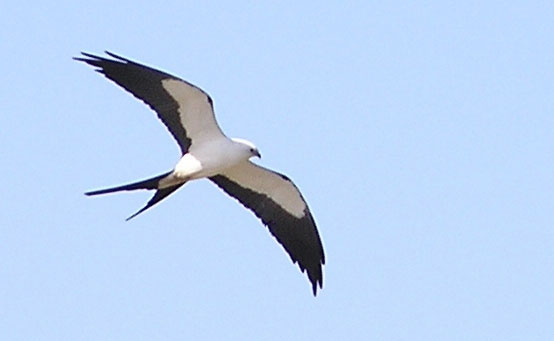 by Patrick Higgins
by Patrick Higgins
I start looking on Valentine’s Day and saw my first swallow-tailed kite of the season on March 1st. sailing just above a hammock in the southern reaches of the Park. It seemed almost paper thin, flashing white then black as it effortlessly swooped, turned and soared, changing direction in an instant with slight adjustments of its scissor-like tail. Native Americans saw these birds as the Great Creator’s window on our world or as messengers between the world above and ours below. For me too they have a spiritual quality and never fail to bring joy.
My excitement was heightened by the knowledge that this herald of spring had journeyed over 4,500 miles from the Pantanal, a vast Everglades-like wetland straddling the borders of Brazil, Bolivia and Paraguay, to nest here and then would repeat the trip home in September.
Males and females are indistinguishable in size and plumage. My kite would already have formed a breeding pair during migration and then together sought out a nest site in a tall tree. In the Fakahatchee swallow-tails favor the very top of slash pines on Four Stakes Prairie. They usually nest in clusters within a few hundred yards of a couple of other pairs laying 2 – 3 white and brown splotched eggs, which need three weeks incubation. From hatching to fledging takes another 6 weeks, although only one usually survives to this stage – the others having been killed, out-competed for food or pushed out of the nest by the first chick to hatch.
In flight Swallow-tailed kites appear petite and delicate as they perform their aerial ballet, but their wing span is over four feet. They seldom flap their wings, making flight look completely effortless. They seize prey like dragonflies and wasps midair and deftly pluck tree-frogs, anoles, small snakes, cicadas and baby birds from the forest canopy. Unlike other raptors they eat on the wing as they continue searching for their next meal, and even drink and bathe on the wing, skimming the surface of ponds and rivers. They mainly feed vertebrates to their young, but most of the adult’s diet consists of insects. Due to their aerial prowess swallow-tails have few natural enemies, but are vulnerable to nocturnal predation by great horned owls.
Sadly their distribution in the United States has been steadily reduced by direct persecution in former times and continuing changes in land use and habitat loss. They now occupy less than 5% percent of their historic range with only a few thousand individuals found in the southeast, Florida and parts of Texas, making each sighting seem even more miraculous.
